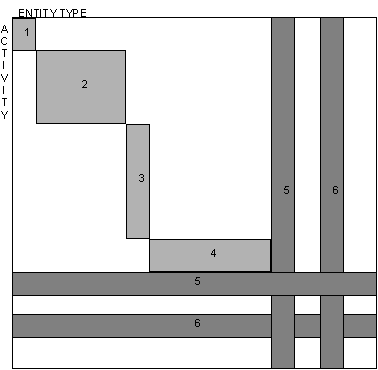

Interaction Clustering can be performed on two matrices:
The rows and columns of these matrices are rearranged to show a "staircase" of clusters from top left to bottom right.
A clustered matrix may contain one or more of the elements shown in the following illustration.

For a description of this matrix, see the following table.
|
Key |
Comment |
Description |
|---|---|---|
|
1 |
Ideal cluster |
The ideal result of interaction clustering is many small clusters of 1 to 16 cells. Expect 2-10 cells in a cluster to contain Cs or Us. Be suspicious, however, if many clusters contain only one cell. This may indicate that the Information Architecture is insufficiently detailed. |
|
2 |
Too large a cluster |
A cluster with more than 16 cells is generally too large. It may be caused by one or more dense activities, entity types, or both, that is, rows, columns, or both with many Creates and Updates. |
|
3 |
Many rows but few columns |
A very tall and narrow cluster often indicates that the rows are at too low a level of detail compared with the columns. |
|
4 |
Many columns but few rows |
A very short and fat cluster often indicates that the columns are at too low a level of detail compared with the rows. |
|
5 |
Dense columns or rows |
These indicate activities or entity types that have previously been identified (automatically or manually) as dense, and excluded from subsequent clustering iterations. Each column or row should be treated as a separate item. Either it should be a cluster in its own right, or it has been removed from clustering for investigation of activity or entity type definition, and clarification or redefinition of each interaction. |
|
6 |
Unclustered columns or rows |
Activities or entity types cannot be included in a cluster because either they have no C or U interactions, or their only C and U interactions are in dense columns or rows. |
The scope of a cluster identifies the smallest group of entity types and activities that together should form the scope of a system. Each cluster is de-coupled as far as possible from all other clusters.
A development project may safely be targeted at the "ideal" scope of a cluster with the minimum need for development coordination with other projects. However, where clusters are small or closely related in the business, or existing systems being replaced cover a wider scope, then a larger optimum scope can be formed by taking two or more complete clusters.
Often, the initial requirement scope of a project, or of a system that is being replaced, does not neatly match the ideal cluster scope. While adjusting the target scope is easy, it is a management role to balance the ideal information structure against the business demands and transition requirements.
|
Copyright © 2014 CA.
All rights reserved.
|
|